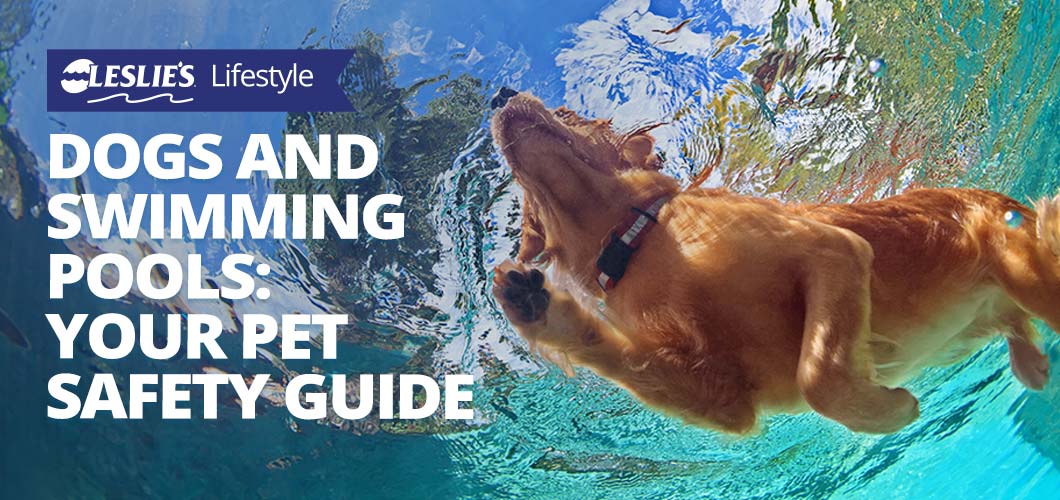
Dogs and Swimming Pools: Your Pet Safety Guide
As temperatures climb higher, we rely on the swimming pool to combat the heat and keep as cool as a cucumber. With increased pool usage comes a greater need for pool safety. This is especially true for children and adults, but what about man’s best friend? If you’re the owner of a furry companion, you know that many dogs love to go swimming, especially in the heat of summer. But can dogs swim in pools?
It's not an entirely bad idea, but there are a few things you should consider first. In this post, we'll go over some dog pool safety advice to help ensure fun in the sun, while also keeping your beloved pet(s) safe in and around the water.
Is Pool Water Safe For a Dog?

Under most circumstances, chlorine or saltwater pools are not harmful for humans or animals. A properly maintained and well-balanced swimming pool can be safe for dogs to swim in. However, there are a few things to remember.
Chlorine can remove natural oil from the skin, which can be problematic for dogs with sensitive skin or those who enjoy frequent dips in the pool. In some cases, this can lead to skin irritation, increased itching and scratching, dry skin and hair, or — in extreme cases — skin rashes.
Can Dogs Drink Pool Water?
If you've recently applied chemicals to the pool, it's best to keep your pup(s) away for a while to avoid accidental ingestion. Certain products, including algaecides, pool shock, or acids, remain toxic until completely diluted in the water. Follow all product label instructions for dosing, application, and pump run time to allow chemicals to completely disperse throughout the pool.
Regularly check water balance to ensure that the water is safe for swimming. If it's not, your dog shouldn't be swimming in it, let alone drinking it.
It’s unavoidable to ingest some amount of water while you’re swimming. Children and animals tend to swallow more than adults. Dogs don’t know any better, and may actively lap up pool water thinking it’s drinking water. Be mindful that your dog doesn't do that, as drinking pool water can lead to an upset stomach — which may cause nausea, vomiting, and even esophageal damage.
In rare cases, dogs drinking excessive amounts of pool water can lead to water intoxication, which may be incredibly dangerous. Water intoxication may produce a major electrolyte imbalance, which can lead to brain damage in extreme cases.
This isn’t to say that pool water is dangerous for your dog and should be avoided at all costs. As they say, too much of a good thing is usually a bad thing. Same goes for ingesting pool water! Therefore, it’s important to keep watch of your pet when in or around the pool, especially after adding pool chemicals.
BONUS TIP: Make sure your dog knows how to safely exit the pool. Once they dive in, do they have a way to get back out again without assistance? If not, this can be a huge safety concern, and you should take measures to provide a step or platform for them to get onto in case of emergency. The first few times your dog is introduced to the pool, entice them to approach the shallow end and show them how to use the pool step, or teach them how to reach the safety platform to exit the pool.
Does Your Dog Like Water?

Curious if your furry companion is prone to swimming in pools (or anywhere like the beach, lakes, etc.)? It’s time to suit up and jump in with him or her! To gauge your dog’s interest in swimming, go into the water first, and see if your dog follows you. If he or she seems confident and happy, it’s likely your dog will become a swimmer.
On the other hand, if your dog seems scared or nervous about getting wet, it’s best not to force them into it. If you're wondering how to get your dog to enjoy the water, the best advice is to make it a positive experience that's on their terms. If you frighten your dog or force them to go into the water, they will likely never want to swim again. What you might think are just first-time jitters about getting wet may be larger insecurities about the water. Be patient, be kind, and let their body language guide the next steps.
Safety First! Never Leave Dogs Unattended Near the Pool
Once you’ve discovered your pup loves to paddle around the pool, it'll be hard to keep them out of it! That said, it’s imperative that you never leave them unattended. No matter how well you think your dog can swim around, they may suddenly struggle with exhaustion. This is a huge pool safety issue for dogs. A dog who's exhausted can struggle with breathing, and might start involuntarily ingesting water. The inhaled water may cause something called pulmonary edema, which means fluid in the lungs. Pulmonary edema can lead to respiratory distress or cardiac arrest, which can happen hours or even days after a near-drowning accident.
Does Your Dog Need a Life Vest or Flotation Device?

The term “doggy paddle” exists for a reason. Dogs are natural swimmers! When they’re first introduced to being in the water, you’ll notice that they’re able to move themselves around quickly — almost instantly. But that doesn’t mean you shouldn’t consider getting a life vest for your dog.
When you’re observing your dog swimming around the pool, do you notice they need a bit of help getting around? Do they get tired when swimming for long periods? Maybe they seem unsure about being in the water? By aiding your pet's ability to float comfortably and safely, a dog life vest can give your beloved canine the extra confidence to swim and play in the water.
Another option is a flotation device. If your pup loves being in the water but tires easily, or if they would rather relax than swim nonstop, a flotation device might be worth looking into. A flotation device, such as a pool float or doggy raft, can be a great way for your dog to spend more time in the water without getting tired or nervous.
Can Your Pool Handle Dogs?
This is a great question to ask yourself, and it's just one more thing to consider. In general, any type of inground pool with a surface like plaster, pebble, or tile is usually fine for both small and large dogs. However, above ground pools or inground pools with vinyl liners may not be suitable. This is because their toenails can damage the pool lining while swimming or exiting the pool.
There’s one other thing to consider when your dog is in the pool: HAIR. If your dog has long hair or tends to shed a lot (especially during the summer), give them a good brushing before getting in the pool. The reason behind this has to do with your pool filter. You want to avoid having a lot of hair in the filter, especially if your dog goes swimming regularly. After all, you want your pool pump to operate normally and not have any issues. In addition to regular brushing, remember to routinely check the skimmer and pump baskets, and keep them free of hair and debris.
Last, but certainly not least, consider the amount of debris your dog brings into the pool each time he or she jumps in. Aside from the hair, they also carry in all kinds of dirt, body oils, and yes, even organic wastes and contaminants we'd rather not mention here. If you're keeping up with proper water chemistry, and your pool is properly sanitized, you likely have nothing to worry about. But if you're not putting in the time and effort to maintain healthy water, you probably shouldn't be swimming after your dog takes a dip in the pool.
BONUS TIP: While swimming can be a fun way to spend time with your beloved dog, it can affect the cleanliness and safety of your pool water. To help maintain a well-balanced pool, bring a water sample to your local Leslie's for a free in-store AccuBlue® water test and treatment plan.
Final Verdict: Can Dogs Swim in Pools?
All in all, swimming can be great exercise for your dog, which helps keep them both healthy and happy. With the right attention and mindfulness, your furry companion can leap, frolic, and doggy paddle in joy and safety inside your swimming pool.